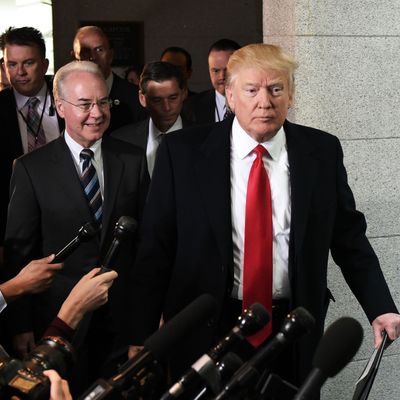
President Trump’s health-care bill has been plagued by one core problem: Its detractors seem to have irreconcilable demands. Some Republicans think it leaves too many uninsured, while others think it leaves too much of Obamacare in place.
For the GOP to cover more people (thus appeasing its Senate moderates), the party would need to preserve even more of Obamacare’s subsidies and structure (further alienating the House’s hard-liners).
Or so we assumed.
In truth, the New York Times’ Margot Sanger-Katz has discovered that the goals of more coverage and less Obamacare aren’t (entirely) contradictory; because Paul Ryan’s Obamacare replacement is so poorly designed, it is literally worse than nothing.
Replacing Obamacare with the Ryan-tested, Trump-approved American Health Care Act (AHCA) would cost 24 million Americans their insurance, according to the Congressional Budget Office. By contrast, repealing Obamacare and replacing it with nothing would cost only 23 million their insurance, according to a CBO score from 2016.
It is not easy to write a bill this bad. Paul Ryan has found a way to construct a system of public subsidies for health insurance that actually boosts the uninsured rate. The AHCA appears to be the Troll 2 of health-care bills: so holistically inept, it’s genuinely impressive.
So, how did the House GOP execute this spectacular own-goal? The explanation seems to lie in the party’s preference for giving government handouts to those who don’t need them. While the AHCA cuts overall federal funding for health-care subsidies, it also expands access to subsidies to individuals who make between $48,000 and $75,000 a year. (Under Obamacare, most Americans who make above $48,000 do not qualify for subsidies.)
This policy combination not only hurts the poor (who get a smaller slice of a shrinking subsidy pie), it also encourages employers to deny their workers health benefits, according to the CBO.
Here’s the issue, in a nutshell: As a large swath of middle-income workers gain access to public subsidies to buy insurance on the individual market, companies will decide that they don’t really need to give such workers insurance coverage (either by restricting benefits, or by treating workers as independent contractors instead of employees). And since there will no longer be an individual mandate, many of these workers will decide to simply go without insurance.
By contrast, in a world where the GOP repeals Obamacare without a replacement, a sizable portion of these workers would retain insurance through their employers. This — combined with the fact that a great many poor people will find AHCA’s subsidies uselessly stingy — leaves Trumpcare covering fewer people than full repeal.
Of course, this doesn’t actually resolve the GOP’s internecine conflict over health-care reform. The fact that “only” 23 million people would lose insurance under full repeal isn’t going to convince Susan Collins to lock arms with Rand Paul.
But it does offer the House Freedom Caucus an excellent talking point.






























